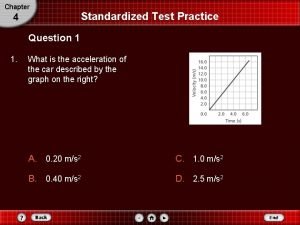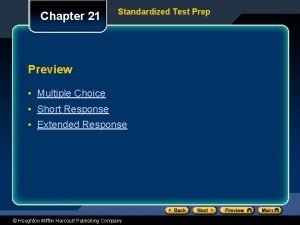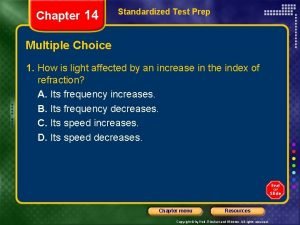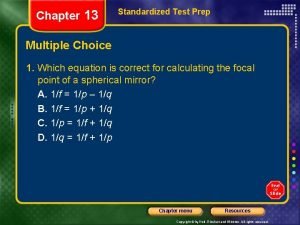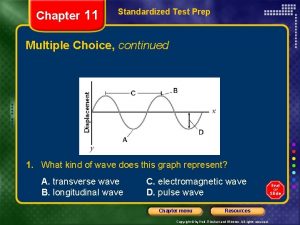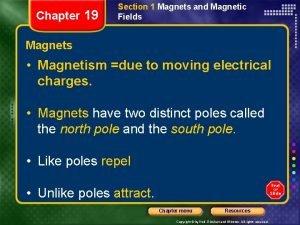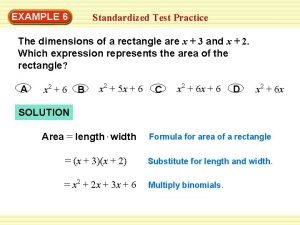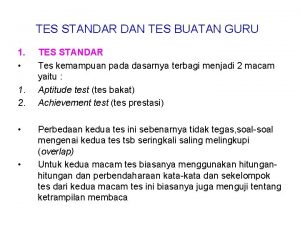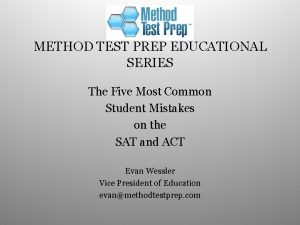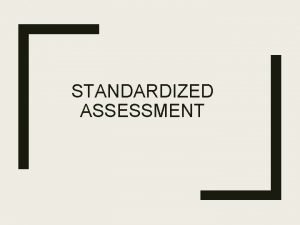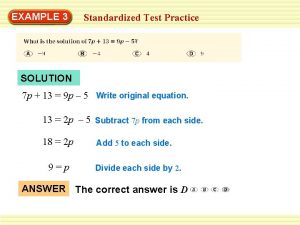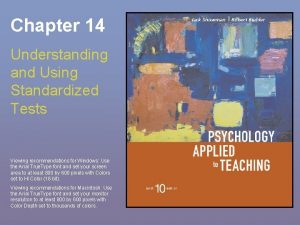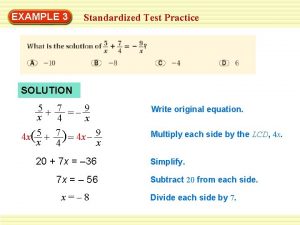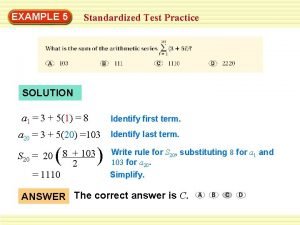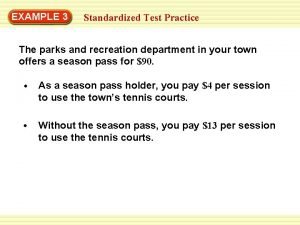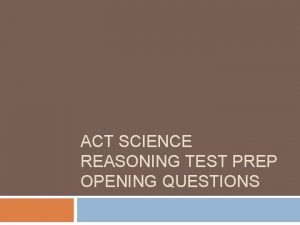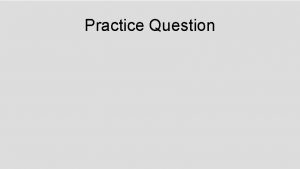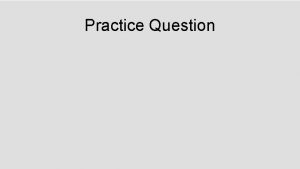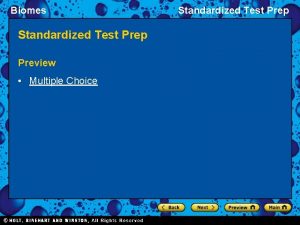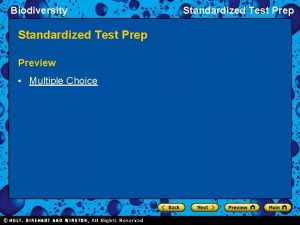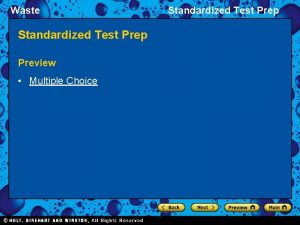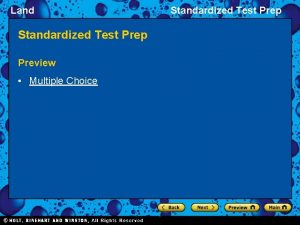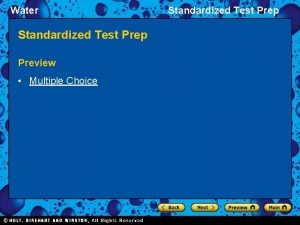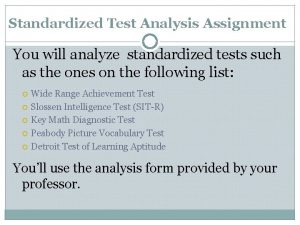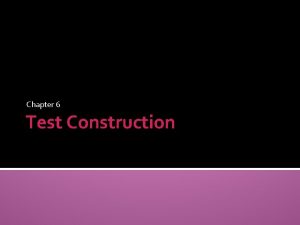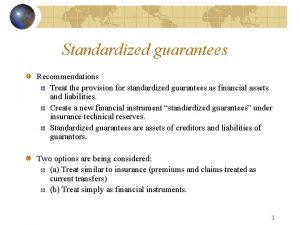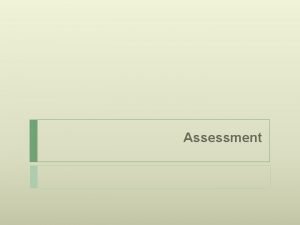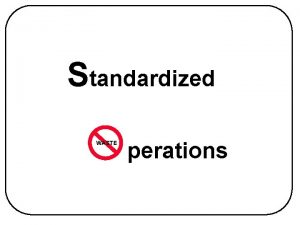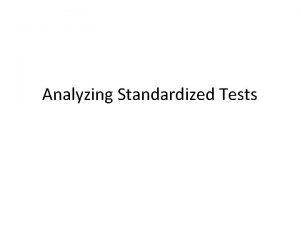Chapter 4 Standardized Test Practice Question 1 1




















- Slides: 20

Chapter 4 Standardized Test Practice Question 1 1. What is the acceleration of the car described by the graph on the right? A. 0. 20 m/s 2 C. 1. 0 m/s 2 B. 0. 40 m/s 2 D. 2. 5 m/s 2

Chapter 4 Standardized Test Practice Question 2 2. What distance will the car described by the above graph have traveled after 4. 0 s? A. 13 m C. 80 m B. 40 m D. 90 m

Chapter 4 Standardized Test Practice Question 3 3. If the car in the graph on the right maintains a constant acceleration, what will its velocity be after 10 s? A. 10 km/h C. 90 km/h B. 25 km/h D. 120 km/h

Chapter 4 Standardized Test Practice Question 4 4. In a tug-of-war, 13 children, with an average mass of 30 kg each, pull westward on a rope with an average force of 150 N per child. Five parents, with an average mass of 60 kg each, pull eastward on the other end of the rope with an average force of 475 N per adult. Assuming that the whole mass accelerates together as a single entity, what is the acceleration of the system? A. 0. 62 m/s 2 E B. 2. 8 m/s 2 W C. 3. 4 m/s 2 E D. 6. 3 m/s 2 W

Chapter 4 Standardized Test Practice Question 5 5. What is the weight of a 225 -kg space probe on the Moon? The acceleration of gravity on the Moon is 1. 62 m/s 2. A. 139 N B. 364 N C. 1. 35× 103 N D. 2. 21× 103 N

Chapter 4 Standardized Test Practice Question 6 6. A 45 -kg child sits on a 3. 2 -kg tire swing. What is the tension in the rope that hangs from a tree branch? A. 310 N B. 4. 4× 102 N C. 4. 5× 102 N D. 4. 7× 102 N

Chapter 4 Standardized Test Practice Question 7 7. The tree branch mentioned in Question 6 sags and the child’s feet rest on the ground. If the tension in the rope is reduced to 220 N, what is the value of the normal force being exerted on the child’s feet? A. 2. 2× 102 N B. 2. 5× 102 N C. 4. 3× 102 N D. 6. 9× 102 N

Chapter 4 Standardized Test Practice Question 8 8. According the graph on the right, what is the force being exerted on the 16 -kg cart? A. 4 N C. 16 N B. 8 N D. 32 N

Chapter 4 Chapter Assessment Questions Question 1 If a golf ball, a cricket ball and a bowling ball are thrown with a same force, which ball will move with a greater acceleration? A. Golf ball B. Cricket ball C. Bowling ball D. The three balls will have equal acceleration.

Chapter 4 Chapter Assessment Questions Answer 1 Answer: B Reason: As , the lesser the mass the greater is the acceleration. Since golf ball has least mass, it will move with greater acceleration.

Chapter 4 Chapter Assessment Questions Question 2 Jack is boating in a river applying a contact force of 30 N, in a direction opposite to the flow of water, at the same time the water is exerting a force of 30 N on the boat. In which direction will the boat move? A. The boat will move in the direction of the flow of water. B. The boat will not move at all. C. The boat will move back and forth within a particular distance. D. The boat will move in the direction opposite to the flow of water.

Chapter 4 Chapter Assessment Questions Answer 2 Answer: B Reason: Since two equal and opposite forces are acting together, the net force is zero. Hence, the boat will not move at all.

Chapter 4 Chapter Assessment Questions Question 3 What is inertia? A. Force. B. Tendency of a body to stay only at rest. C. Tendency of a body to move with constant acceleration. D. Tendency of a body to move with constant velocity.

Chapter 4 Chapter Assessment Questions Answer 3 Answer: D Reason: Inertial of a body is the tendency of a body to stay at rest and/or to move with constant velocity, remember being at rest is simply a special case of state of constant velocity, v = 0 m/s.

Chapter Assessment Questions 4 Question 4 If the weight of a person on Earth is 120 N, what will his weight be on the Moon? (Gravity on Moon is six times less than the gravity on Earth. ) A. B. C. D.

Chapter 4 Chapter Assessment Questions Answer 4 Answer: A Reason: Gravity on Moon is Mass of the person is (since mass = weight/g) Weight of person on Moon = Gravity on Moon × mass of person So, weight of the person on Moon =

Chapter 4 Chapter Assessment Questions Question 5 What happens when the drag force is equal to the force of gravity? A. Object comes to rest. B. Object moves with constant acceleration. C. Object moves with constant velocity. D. Velocity of the object increases.

Chapter 4 Chapter Assessment Questions Answer 5 Answer: C Reason: When drag force equals the force due to gravity, the net force acting on the object is zero. As a result of which, the object moves with constant velocity, which is called terminal velocity.

Chapter 4 Chapter Assessment Questions Question 6 If a table-tennis ball, a football and a baseball are dropped in air which ball will have the greater terminal velocity? A. Table-tennis ball B. Football C. Baseball D. All the balls will reach the terminal velocity at the same time.

Chapter 4 Chapter Assessment Questions Answer 6 Answer: C Reason: When light objects with large surface areas are falling, the drag force has a substantial effect on their motion, and they quickly reach terminal velocity. Heavier more compact objects are not affected as much by the drag force. Baseball being heavier and more compact will have the greater terminal velocity in air.
 4-4 standardized test prep answers
4-4 standardized test prep answers A rock climber's shoe loosens a rock and her climbing buddy
A rock climber's shoe loosens a rock and her climbing buddy Chapter 21 standardized test practice answers
Chapter 21 standardized test practice answers Chapter 14 standardized test practice answers
Chapter 14 standardized test practice answers Chapter 13 standardized test practice answers
Chapter 13 standardized test practice answers 10-6 standardized test prep answers
10-6 standardized test prep answers Chapter 2 standardized test practice answers
Chapter 2 standardized test practice answers Chapter 19 standardized test practice answers
Chapter 19 standardized test practice answers A rock climber's shoe loosens a rock and her climbing buddy
A rock climber's shoe loosens a rock and her climbing buddy 6 standardized test practice
6 standardized test practice Costa level questions science
Costa level questions science Contoh tes standar
Contoh tes standar Circuit training standardized test prep answers
Circuit training standardized test prep answers Define standardized test
Define standardized test 4-3 standardized test prep answers
4-3 standardized test prep answers Standardized test characteristics
Standardized test characteristics Standardized test meaning
Standardized test meaning Extraneous definition math
Extraneous definition math 5-1 standardized test prep
5-1 standardized test prep 3-5 standardized test prep
3-5 standardized test prep Practice test 1 science reasoning test
Practice test 1 science reasoning test
